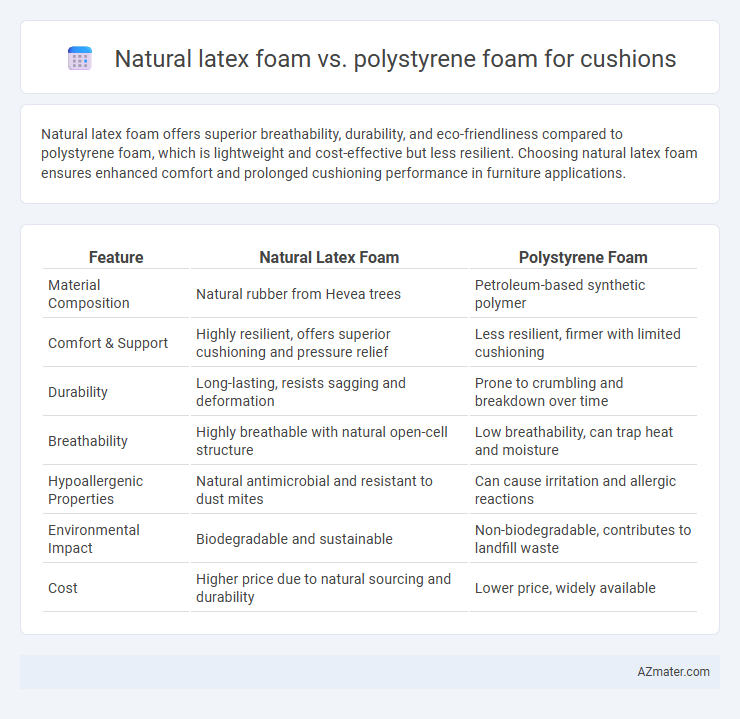Natural latex foam offers superior breathability, durability, and eco-friendliness compared to polystyrene foam, which is lightweight and cost-effective but less resilient. Choosing natural latex foam ensures enhanced comfort and prolonged cushioning performance in furniture applications.
Table of Comparison
| Feature | Natural Latex Foam | Polystyrene Foam |
|---|---|---|
| Material Composition | Natural rubber from Hevea trees | Petroleum-based synthetic polymer |
| Comfort & Support | Highly resilient, offers superior cushioning and pressure relief | Less resilient, firmer with limited cushioning |
| Durability | Long-lasting, resists sagging and deformation | Prone to crumbling and breakdown over time |
| Breathability | Highly breathable with natural open-cell structure | Low breathability, can trap heat and moisture |
| Hypoallergenic Properties | Natural antimicrobial and resistant to dust mites | Can cause irritation and allergic reactions |
| Environmental Impact | Biodegradable and sustainable | Non-biodegradable, contributes to landfill waste |
| Cost | Higher price due to natural sourcing and durability | Lower price, widely available |
Introduction: Natural Latex Foam vs Polystyrene Foam for Cushions
Natural latex foam offers superior elasticity, breathability, and hypoallergenic properties compared to polystyrene foam, making it ideal for high-quality cushions. Polystyrene foam, often used in budget-friendly products, provides firm support but lacks the durability and natural moisture-wicking capabilities of latex. Choosing between natural latex and polystyrene foam impacts cushion comfort, longevity, and environmental sustainability.
Material Composition and Manufacturing Process
Natural latex foam is primarily made from the sap of rubber trees (Hevea brasiliensis), undergoing a whipped or Dunlop process that involves vulcanization and drying, resulting in a resilient, breathable, and biodegradable cushion material. Polystyrene foam, derived from petroleum-based styrene monomers, is produced through a polymerization process involving the expansion of polystyrene beads using steam, creating a lightweight, rigid, and insulating foam widely used in cushioning applications. The natural latex foam's open-cell structure offers superior elasticity and moisture resistance compared to the closed-cell, non-breathable structure of polystyrene foam.
Comfort and Support: Comparing Resilience and Bounce
Natural latex foam offers superior comfort and support with its high resilience and responsive bounce, adapting well to body contours and providing consistent pressure relief. Polystyrene foam, often firmer and less elastic, tends to compress quickly and provides less adaptive support, resulting in reduced cushioning longevity. Latex foam's natural elasticity ensures prolonged durability and a balanced combination of softness and support ideal for cushions.
Breathability and Temperature Regulation
Natural latex foam offers superior breathability and temperature regulation due to its open-cell structure and moisture-wicking properties, which enhance airflow and prevent heat retention. Polystyrene foam, in contrast, is denser and less permeable, often trapping heat and limiting ventilation, resulting in reduced comfort during extended use. For cushions, natural latex foam ensures a cooler, more breathable seating experience, making it a preferred material for maintaining optimal temperature control.
Durability and Longevity of Cushion Foams
Natural latex foam offers superior durability and longevity compared to polystyrene foam, maintaining its shape and resilience over extended use. Polystyrene foam tends to compress and degrade faster under regular pressure, leading to reduced cushioning support and comfort. The inherent elasticity and antimicrobial properties of natural latex contribute to prolonged lifespan and sustained performance in cushions.
Environmental Impact: Sustainability Considerations
Natural latex foam is derived from renewable rubber tree sap, making it biodegradable and compostable, which significantly reduces landfill waste and environmental pollution. Polystyrene foam, commonly petroleum-based, poses serious sustainability concerns due to its non-biodegradability, persistence in ecosystems, and challenges in recycling. Choosing natural latex foam supports eco-friendly practices by minimizing carbon footprint and promoting renewable resources in cushion production.
Health and Safety: Allergenicity and Toxicity Factors
Natural latex foam is derived from rubber tree sap and is hypoallergenic, resistant to dust mites, mold, and bacteria, making it a safer option for individuals with allergies or respiratory sensitivities. Polystyrene foam contains chemical additives and can off-gas volatile organic compounds (VOCs), potentially causing respiratory irritation and allergic reactions in sensitive individuals. Health-conscious consumers often prefer natural latex foam due to its non-toxic, eco-friendly properties and reduced allergenicity compared to synthetic polystyrene alternatives.
Cost and Affordability Analysis
Natural latex foam typically costs between $50 and $100 per cubic foot, making it more expensive than polystyrene foam, which averages around $20 to $30 per cubic foot. The higher price of natural latex foam reflects its durability, biodegradability, and hypoallergenic properties, while polystyrene foam offers a budget-friendly, lightweight alternative with lower longevity. When evaluating cost-effectiveness for cushions, polystyrene foam suits short-term, low-cost needs, whereas natural latex foam represents a longer-term investment with improved comfort and environmental benefits.
Common Applications and Use Cases
Natural latex foam is commonly used in premium cushions for furniture, bedding, and ergonomic seating due to its durability, breathability, and hypoallergenic properties. Polystyrene foam is frequently applied in low-cost cushions, disposable seating, and packaging inserts where lightweight and affordability are prioritized over comfort. Natural latex foam suits applications requiring resilience and long-term support, while polystyrene foam fits temporary or cost-sensitive cushioning needs.
Conclusion: Choosing the Right Foam for Your Cushions
Natural latex foam offers superior durability, breathability, and eco-friendliness, making it ideal for cushions requiring long-term comfort and support. Polystyrene foam provides a lightweight and cost-effective option with good initial firmness but lacks the resilience and environmental benefits of latex. Selecting the right foam depends on balancing budget constraints with desired comfort, longevity, and sustainability attributes.

Infographic: Natural latex foam vs Polystyrene foam for Cushion
 azmater.com
azmater.com